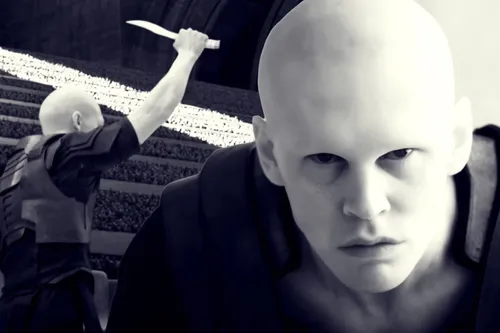Denis Villeneuve’s epic adaptation of Frank Herbert’s seminal sci-fi novel, Dune, continues to captivate audiences with its stunning visuals and rich storytelling. In Dune: Part Two, one of the most striking additions to the cinematic universe is the introduction of Austin Butler as the villainous Feyd-Rautha in a mesmerizing black-and-white sequence.
Villeneuve’s decision to split Herbert’s expansive narrative into two parts allowed for the inclusion of key characters who were absent from the first movie. Feyd-Rautha, the nephew of Baron Harkonnen, emerges as a formidable presence in the sequel, portrayed with a monstrous appearance that sets him apart from previous interpretations.
The black-and-white sequences depicting Feyd-Rautha’s gladiatorial battles on the Harkonnen homeworld of Giedi Prime serve as a visual departure from the sandy landscapes of Arrakis. Villeneuve’s creative choice to present Giedi Prime in stark monochrome not only distinguishes it from other settings in the film but also highlights the bleak and oppressive atmosphere of the planet.
In an interview, Villeneuve revealed his intention to capture the “plastic world” of Giedi Prime and explore how the absence of sunlight from its black sun shapes the psyche of its inhabitants. By utilizing a black-and-white palette, cinematographer Greig Fraser effectively conveys the brutality and coldness of Feyd-Rautha’s environment, emphasizing the character’s viciousness and the primitive culture that surrounds him.
The infrared palette used in the black-and-white sequences adds depth to the portrayal of Giedi Prime, immersing viewers in a world devoid of nature and suffused with an aura of darkness. This creative approach not only enhances the visual storytelling of Dune: Part Two but also provides insights into the political dynamics and societal structures of the Harkonnen-controlled planet.
As audiences delve deeper into the world of Dune through Villeneuve’s masterful direction and the captivating performances of the cast, the black-and-white sequences featuring Feyd-Rautha stand out as a testament to the film’s commitment to pushing the boundaries of visual storytelling. With its bold aesthetic choices and nuanced exploration of character and world-building, Dune: Part Two continues to leave a lasting impression on viewers, setting the stage for an epic conclusion to the saga.
FAQ
When was Dune: Part Two released?
Dune: Part Two is currently playing in theaters. As of now, there is no information available regarding its digital release or availability on streaming platforms.
Who plays Feyd-Rautha in Dune: Part Two?
Austin Butler portrays Feyd-Rautha, the villainous nephew of Baron Harkonnen, in Dune: Part Two. Butler’s performance brings a menacing presence to the character, adding depth to the sequel’s narrative.
Why are there black-and-white sequences in Dune: Part Two?
The black-and-white sequences in Dune: Part Two serve to depict Feyd-Rautha’s gladiatorial battles on the planet Giedi Prime, the homeworld of the Harkonnen family. This creative choice by director Denis Villeneuve and cinematographer Greig Fraser enhances the atmosphere of Giedi Prime and emphasizes the bleakness of its environment.
How does the black sun affect Giedi Prime and its inhabitants?
The black sun of Giedi Prime is a central aspect of the planet’s ecosystem, influencing its landscape and the psyche of its inhabitants. Director Denis Villeneuve explains that the lack of sunlight contributes to the planet’s “plastic world” and shapes the primitive culture and brutalist society depicted in the film.
Is Dune: Part Two a faithful adaptation of Frank Herbert’s novel?
While Dune: Part Two draws inspiration from Frank Herbert’s novel, it also takes creative liberties to adapt the story for the screen. Certain characters and plot elements may differ from the source material, but the film remains faithful to the overarching themes and essence of Herbert’s work.
Will there be a sequel to Dune: Part Two?
As of now, there has been no official announcement regarding a sequel to Dune: Part Two. However, given the success and critical acclaim of the film, it is possible that further installments in the Dune series could be considered in the future.
Stay tuned for updates and further developments regarding Dune: Part Two and the future of the franchise as it continues to unfold on the big screen.
